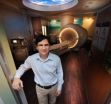(Press-News.org) Trying to keep an image we've just seen in memory can leave us blind to things we are 'looking' at, according to the results of a new study supported by the Wellcome Trust.
It's been known for some time that when our brains are focused on a task, we can fail to see other things that are in plain sight. This phenomenon, known as 'inattentional blindness', is exemplified by the famous 'invisible gorilla' experiment in which people watching a video of players passing around a basketball and counting the number of passes fail to observe a man in a gorilla suit walking across the centre of the screen.
The new results reveal that our visual field does not need to be cluttered with other objects to cause this 'blindness' and that focusing on remembering something we have just seen is enough to make us unaware of things that happen around us.
Professor Nilli Lavie from UCL Institute of Cognitive Neuroscience, who led the study, explains: "An example of where this is relevant in the real world is when people are following directions on a sat nav while driving.
"Our research would suggest that focusing on remembering the directions we've just seen on the screen means that we're more likely to fail to observe other hazards around us on the road, for example an approaching motorbike or a pedestrian on a crossing, even though we may be 'looking' at where we're going."
Participants in the study were given a visual memory task to complete while the researchers looked at the activity in their brains using functional magnetic resonance imaging. The findings revealed that while the participants were occupied with remembering an image they had just been shown, they failed to notice a flash of light that they were asked to detect, even though there was nothing else in their visual field at the time.
The participants could easily detect the flash of light when their mind was not loaded, suggesting that they had established a 'load induced blindness'. At the same time, the team observed that there was reduced activity in the area of the brain that processes incoming visual information - the primary visual cortex.
Professor Lavie adds: "The 'blindness' seems to be caused by a breakdown in visual messages getting to the brain at the earliest stage in the pathway of information flow, which means that while the eyes 'see' the object, the brain does not."
The idea that there is competition in the brain for limited information processing power is known as load theory and was first proposed by Professor Lavie more than a decade ago. The theory explains why the brain fails to detect even conspicuous events in the visual field, like the man in a gorilla suit, when attention is focused on a task that involves a high level of information load.
The research reveals a pathway of competition in the brain between new visual information and our short-term visual memory that was not appreciated before. In other words, the act of remembering something we've seen that isn't currently in our field of vision means that we don't see what we're looking at.
The findings are published in the 'Journal of Cognitive Neuroscience'.
### END
Study reveals how memory load leaves us 'blind' to new visual information
2012-10-01
ELSE PRESS RELEASES FROM THIS DATE:
Physiological role of a novel hormone FNDC5/irisin revealed in humans
2012-10-01
Oxford, October 1, 2012 - A research team led by Dr. Christos Mantzoros, MD, PhD, at Beth Israel Deaconess Medical Center, Harvard Medical School, has published new findings elucidating the molecular and clinical role of FNDC5/irisin in humans.
Irisin is a recently identified hormone secreted from muscle cells that has been found to serve as a chemical messenger providing key exercise-induced health benefits in mice. In these earlier studies, irisin showed direct effects on 'browning' of white fat which would lead to burning of excess calories. Discovery of irisin therefore ...
Computerized osteoporosis detection
2012-10-01
A computerized approach to examining patient bone X-rays for diagnosis of osteoporosis could side-step the subjectivity associated with visual examination, according to a new research paper in the International Journal of Biomedical Engineering and Technology published in October.
Neelesh Kumar of the Central Scientific Instruments Organisation in Chandigarh, India, and colleagues recognized that the bone disorder osteoporosis is on the increase but that diagnosis using X-ray images of the patient's skeleton often lead to false positives and false negatives because visual ...
The chemical memory of seawater
2012-10-01
Water does not forget, says Prof. Boris Koch, a chemist at the Alfred Wegener Institute for Polar and Marine Research in the Helmholtz Association. Irrespective of what happens in the sea: whether the sun shines, algae bloom or a school of dolphins swims through a marine area – everything and everyone leaves biomolecular tracks. With the help of a combination of new techniques, Boris Koch and colleagues can now identify and retrace some of these. In a special volume of the open access journal Biogeosciences, these scientists report on how these analyses work and which ...
First images of Landau levels revealed
2012-10-01
Physicists have directly imaged Landau Levels – the quantum levels that determine electron behaviour in a strong magnetic field – for the first time since they were theoretically conceived of by Nobel prize winner Lev Landau in 1930.
Using scanning tunnelling spectroscopy - a spatially resolved probe that interacts directly with the electrons - scientists at institutions including the University of Warwick and Tohoku University have revealed the internal ring-like structure of these Landau Levels at the surface of a semiconductor.
The experimental challenge in the work ...
UK-led project unravels the structures of membrane proteins
2012-10-01
The European Drug Initiative on Channels and Transporters (EDICT), which comes to an end this year, focused on membrane proteins. They make up a third of all proteins in every organism and play a key role in many human diseases.
Membrane proteins are difficult to study and poorly understood, but the four-year EDICT project has enabled a major step forward in our understanding of the structures – and even more importantly the functions – of over 30 of these proteins. Bringing together over 100 researchers across 12 countries, the project has developed better and faster ...
'Green Brain' project to create an autonomous flying robot with a honey bee brain
2012-10-01
Scientists at the Universities of Sheffield and Sussex are embarking on an ambitious project to produce the first accurate computer models of a honey bee brain in a bid to advance our understanding of Artificial Intelligence (AI), and how animals think.
The team will build models of the systems in the brain that govern a honey bee's vision and sense of smell. Using this information, the researchers aim to create the first flying robot able to sense and act as autonomously as a bee, rather than just carry out a pre-programmed set of instructions.
If successful, this ...
Yearlong MAGIC climate study launches
2012-10-01
UPTON, NY - A Horizon Lines container ship outfitted with meteorological and atmospheric instruments installed by U.S. Department of Energy (DOE) scientists from Argonne National Laboratory and Brookhaven National Laboratory will begin taking data today for a yearlong mission aimed at improving the representation of clouds in climate models. The study, a collaborative effort between DOE's Atmospheric Radiation Measurement (ARM) program Climate Research Facility and Horizon Lines, marks the first official marine deployment of the second ARM Mobile Facility, AMF2, and is ...
Nothing to sneeze at: Scientists find cheating ragweed behaves better with its kin
2012-10-01
Cheating. Conflict. Competition. It may sound like a soap opera but this is the complex life of the despised ragweed plant.
And in the highly competitive fight for nutrients, researchers have found ragweed will behave altruistically with its siblings, investing precious resources for the benefit of the group.
A growing body of work suggests plants recognize and respond to the presence and identity of their neighbours and the findings, published online in the journal PLOS ONE, provide further evidence of the importance of family in preserving cooperation within and ...
Evidence-based guidelines enable optimal treatment of common low-back pain
2012-10-01
AUGUSTA, Ga. – While scientific evidence suggests that less is typically more when it comes to diagnosing and treating low-back pain in the U.S., the number of expensive imaging exams and surgeries done on patients continues to rise, researchers say.
More than 25 percent of American adults report at least one episode of acute low-back pain in the past three months and the annual total price tag is about $100 billion, according to a study in an issue of the Journal of the American College of Radiology focusing on health care reform.
"For the great majority of patients, ...
Longest fiber-optic sensor network developed
2012-10-01
This press release is available in Spanish.Montserrat Fernández-Vallejo, a telecommunications engineer and graduate of the UPNA-Public University of Navarre, has experimentally developed various fibre-optic sensor networks for the remote monitoring of large infrastructures. Specifically, she has managed to develop the largest network so far in existence —measuring 250 km—, which is equipped with a multiplexing capability, (which enables two or more information channels to be combined within a single transmission medium).
This technological development in the field of ...


